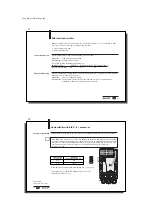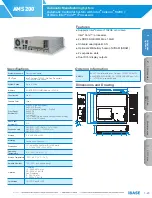
31
deutsch
31
E
Function Description
Processing data carrier
Copying from Head 1
to Head 2
A copying command requires that there be a data carrier in front of both read/write heads
(even if dynamic mode is configured). The read is performed with simultaneous data transmis-
sion (even if simultaneous data transmission is not configured).
The entire process is controlled with the bit header from Head 1. The start address and
number of bytes apply both for reading on Head 1 and writing on Head 2. The copy command
is handled essentially the same as for reading with simultaneous data transmission. In addi-
tion, the data which are sent to the input buffer are written at the same time from Head 2 to
the data carrier.
The AE-bit is only set once the write procedure on Head 2 has been successfully concluded.
If the GR-bit is set while a copy command is running, both read/write heads are placed in the
base state.
C60_1-023_819395_0508_en.p65
32
32
E
To be able to use the CRC check, the data carrier must first be initialized with the command
identifier 12
Hex
(see 36). The CRC initialization is used like a normal write job. The latter is
rejected (with an error message) if the processor recognizes that the data carrier does not
contain the correct CRC. Data carriers as shipped from the factory (all data are 0) can imme-
diately be programmed with a CRC check.
If CRC_16 data checking is activated, a special error message is output to the interface
whenever a CRC error is detected.
If the error message is not caused by a failed write request, it may be assumed that one or
more memory cells on the data carrier is defective. That data carrier must then be replaced.
If the CRC error is however due to a failed write request, you must reinitialize the data carrier
in order to continue using it.
The checksum is written to the data carrier as a 2-byte wide datum. Two bytes per page are
'lost', i.e., the page size becomes 30 bytes or 62 bytes depending on data carrier type (setup
of page size see 16). This means that the actual usable number of bytes is reduced:
Data carrier type
Usable bytes
128 bytes
=
120 bytes
256 bytes
=
240 bytes
511 bytes *)
=
450 bytes
1023 bytes *)
=
930 bytes
2047 bytes *)
=
1922 bytes
2048 bytes
=
1984 bytes
8192 bytes
=
7936 bytes
*) The last data carrier page for these EEPROM-based data carriers is not available.
CRC initialization
Function Description
Processing data carrier
















































